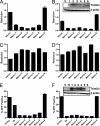Balancing selection and the evolution of functional polymorphism in Old World monkey TRIM5alpha
- PMID: 17142324
- PMCID: PMC1679755
- DOI: 10.1073/pnas.0605838103
Balancing selection and the evolution of functional polymorphism in Old World monkey TRIM5alpha
Abstract
Retroviral restriction factor TRIM5alpha exhibits a high degree of sequence variation among primate species. It has been proposed that this diversity is the cumulative result of ancient, lineage-specific episodes of positive selection. Here, we describe the contribution of within-species variation to the evolution of TRIM5alpha. Sampling within two geographically distinct Old World monkey species revealed extensive polymorphism, including individual polymorphisms that predate speciation (shared polymorphism). In some instances, alleles were more closely related to orthologues of other species than to one another. Both silent and nonsynonymous changes clustered in two domains. Functional assays revealed consequences of polymorphism, including differential restriction of a small panel of retroviruses by very similar alleles. Together, these features indicate that the primate TRIM5alpha locus has evolved under balancing selection. Except for the MHC there are few, if any, examples of long-term balancing selection in primates. Our results suggest a complex evolutionary scenario, in which fixation of lineage-specific adaptations is superimposed on a subset of critical polymorphisms that predate speciation events and have been maintained by balancing selection for millions of years.
Conflict of interest statement
The authors declare no conflict of interest.
Figures




Similar articles
-
Trans-species polymorphism in humans and the great apes is generally maintained by balancing selection that modulates the host immune response.Hum Genomics. 2015 Sep 4;9(1):21. doi: 10.1186/s40246-015-0043-1. Hum Genomics. 2015. PMID: 26337052 Free PMC article. Review.
-
Evolutionary and Functional Analysis of Old World Primate TRIM5 Reveals the Ancient Emergence of Primate Lentiviruses and Convergent Evolution Targeting a Conserved Capsid Interface.PLoS Pathog. 2015 Aug 20;11(8):e1005085. doi: 10.1371/journal.ppat.1005085. eCollection 2015 Aug. PLoS Pathog. 2015. PMID: 26291613 Free PMC article.
-
The ABO blood group is a trans-species polymorphism in primates.Proc Natl Acad Sci U S A. 2012 Nov 6;109(45):18493-8. doi: 10.1073/pnas.1210603109. Epub 2012 Oct 22. Proc Natl Acad Sci U S A. 2012. PMID: 23091028 Free PMC article.
-
Positive selection of primate TRIM5alpha identifies a critical species-specific retroviral restriction domain.Proc Natl Acad Sci U S A. 2005 Feb 22;102(8):2832-7. doi: 10.1073/pnas.0409853102. Epub 2005 Feb 2. Proc Natl Acad Sci U S A. 2005. PMID: 15689398 Free PMC article.
-
Shared epitopes among HLA class II alleles: gene conversion, common ancestry and balancing selection.Immunol Today. 1991 Nov;12(11):411-4. doi: 10.1016/0167-5699(91)90143-H. Immunol Today. 1991. PMID: 1723876 Review.
Cited by
-
Antiretroviral activity of ancestral TRIM5alpha.J Virol. 2008 Mar;82(5):2089-96. doi: 10.1128/JVI.01828-07. Epub 2007 Dec 12. J Virol. 2008. PMID: 18077724 Free PMC article.
-
Transspecies dimorphic allelic lineages of the proteasome subunit beta-type 8 gene (PSMB8) in the teleost genus Oryzias.Proc Natl Acad Sci U S A. 2010 Dec 14;107(50):21599-604. doi: 10.1073/pnas.1012881107. Epub 2010 Nov 23. Proc Natl Acad Sci U S A. 2010. PMID: 21098669 Free PMC article.
-
Molecular evolution of the antiretroviral TRIM5 gene.Immunogenetics. 2009 Mar;61(3):163-76. doi: 10.1007/s00251-009-0358-y. Epub 2009 Feb 24. Immunogenetics. 2009. PMID: 19238338 Review.
-
Trans-species polymorphism in humans and the great apes is generally maintained by balancing selection that modulates the host immune response.Hum Genomics. 2015 Sep 4;9(1):21. doi: 10.1186/s40246-015-0043-1. Hum Genomics. 2015. PMID: 26337052 Free PMC article. Review.
-
Hare TRIM5α restricts divergent retroviruses and exhibits significant sequence variation from closely related lagomorpha TRIM5 genes.J Virol. 2010 Dec;84(23):12463-8. doi: 10.1128/JVI.01514-10. Epub 2010 Sep 22. J Virol. 2010. PMID: 20861252 Free PMC article.
References
MeSH terms
Substances
Associated data
- Actions
- Actions
- Actions
- Actions
- Actions
- Actions
- Actions
- Actions
- Actions
- Actions
LinkOut - more resources
Full Text Sources
Research Materials

